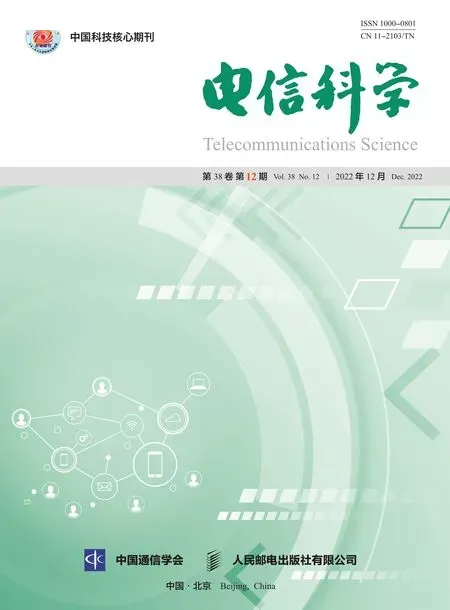一種面向RDSM系統(tǒng)的基于遺傳算法優(yōu)化色散矩陣的方法
章鵬,金小萍,陳東曉
一種面向RDSM系統(tǒng)的基于遺傳算法優(yōu)化色散矩陣的方法
章鵬,金小萍,陳東曉
(中國(guó)計(jì)量大學(xué)信息工程學(xué)院浙江省電磁波信息技術(shù)與計(jì)量檢測(cè)重點(diǎn)實(shí)驗(yàn)室,浙江 杭州 310018)
矩形差分空間調(diào)制(rectangular differential spatial modulation,RDSM)是一種多天線非相干調(diào)制技術(shù),該技術(shù)頻譜效率高,低功耗且無(wú)信道估計(jì)開(kāi)銷,特別適用于信道快速變化的車聯(lián)網(wǎng)、物聯(lián)網(wǎng)、6G蜂窩網(wǎng)絡(luò)等未來(lái)通信系統(tǒng)。然而發(fā)射端的稀疏酉矩形空時(shí)色散矩陣(dispersion matrix,DM)的構(gòu)造問(wèn)題一直是個(gè)難點(diǎn),而當(dāng)前使用的隨機(jī)搜索優(yōu)化方法具有極高的計(jì)算復(fù)雜度,對(duì)此,提出了一種低復(fù)雜度遺傳算法(genetic algorithm,GA)。根據(jù)秩與行列式標(biāo)準(zhǔn)最大化準(zhǔn)則(rank and determinant criterion,RDC)的方法計(jì)算適應(yīng)度值,可避免差分系統(tǒng)中所需的分類討論。根據(jù)星座旋轉(zhuǎn)對(duì)稱性的特點(diǎn),降低GA單次迭代的計(jì)算復(fù)雜度。仿真結(jié)果表明,優(yōu)化得到的DMs(DM set)顯著改善了RDSM系統(tǒng)誤比特率(bit error rate,BER)性能,對(duì)比隨機(jī)搜索,低復(fù)雜度遺傳算法有效提高了RDSMS的DMs優(yōu)化效率,優(yōu)化DMs所需的計(jì)算復(fù)雜度約為隨機(jī)搜索的0.1%。
差分空間調(diào)制;索引調(diào)制;遺傳算法;色散矩陣;星座旋轉(zhuǎn)
0 引言
索引調(diào)制[1](index modulation,IM)是近年來(lái)提出的一種新型調(diào)制技術(shù),在頻譜和能量效率以及硬件實(shí)現(xiàn)復(fù)雜度方面具有突出優(yōu)勢(shì),有望成為6G綠色無(wú)線通信的關(guān)鍵候選技術(shù)。其中,空間調(diào)制[2-4](spatial modulation,SM)是一種在空域的索引調(diào)制,具有低功耗和無(wú)信道間干擾(inter-channel interference,ICI)的特點(diǎn),得到了最廣泛的研究。差分空間調(diào)制[5](differential spatial modulation,DSM)在SM的優(yōu)勢(shì)上,實(shí)現(xiàn)了非相干檢測(cè),克服了信道狀態(tài)信息(channel state information,CSI)難以獲取的問(wèn)題。該技術(shù)特別適用于CSI多變的高速通信環(huán)境,在新一代通信系統(tǒng)中擁有巨大的應(yīng)用前景。
矩形差分空間調(diào)制(rectangular differential spatial modulation,RDSM)[6]是基于DSM提出的一種新方案,該技術(shù)將DSM方形的色散矩陣(dispersion matrix,DM)拓展成矩形的矩陣,簡(jiǎn)化了映射關(guān)系,并獲得了更高的傳輸速率,實(shí)現(xiàn)系統(tǒng)傳輸速率、發(fā)送分集增益、系統(tǒng)復(fù)雜度之間的平衡,獲得了廣泛的研究[6-8]。其中,文獻(xiàn)[7]提出了幅度相移鍵控輔助矩形差分空間調(diào)制(amplitude phase shift keying aided RDSM,APSK-RDSM),通過(guò)APSK進(jìn)一步提高了RDSM的頻譜效率,但這種方案的發(fā)射信號(hào)的能量不恒定,在參考?jí)K信號(hào)傳輸頻率較低的情況下錯(cuò)誤傳播影響較大;文獻(xiàn)[8]提出的空時(shí)分組編碼矩形差分空間調(diào)制(space-time block coded RDSM,STBC-RDSM)方案中,發(fā)射信號(hào)能量恒定,并利用RDSM簡(jiǎn)化STBC在DSM中的映射關(guān)系,得到的頻譜效率均優(yōu)于DSM同類編碼調(diào)制方式。
然而,上述對(duì)RDSM的研究中,在發(fā)射端DM集(dispersion matrix set,DMs)的構(gòu)造上,都還是采用傳統(tǒng)的遍歷搜索法,不僅復(fù)雜度過(guò)高,且性能也不能保證是最佳,這是當(dāng)前RDSM系統(tǒng)研究的一個(gè)瓶頸。而對(duì)于DMs的設(shè)計(jì),也有相關(guān)的研究。在先前設(shè)計(jì)空時(shí)移鍵控(space-time shift keying,STSK)[9]的DMs時(shí),文獻(xiàn)[10]提出了低復(fù)雜度搜索算法,利用秩與行列式標(biāo)準(zhǔn)最大化準(zhǔn)則[11](rank and determinant criterion,RDC)快速搜索得到DMs。然而這種STSK的DMs并不具有稀疏酉特性。文獻(xiàn)[12]利用代數(shù)域拓展的方法得到了DSM固定的一組DMs,避免了大量的搜索計(jì)算。但這種方法生成的矩陣集雖具有稀疏酉特性,然而矩陣是方形而非矩形的,無(wú)法直接應(yīng)用在RDSM系統(tǒng)中。
針對(duì)DMs的優(yōu)化問(wèn)題,考慮引入啟發(fā)式算法。其中,相比粒子群算法、模擬退火算法等其他智能算法,遺傳算法(genetic algorithm,GA)具有群體搜索和變異等特性,更適用于高度非線性問(wèn)題[13-14],特別是DM的矩陣組合優(yōu)化問(wèn)題,可以避免不成熟收斂。此外, GA還有可擴(kuò)展性,易與其他技術(shù)相結(jié)合。
基于上述背景,提出了一種基于星座旋轉(zhuǎn)對(duì)稱性遺傳算法優(yōu)化DMs的RDSM系統(tǒng),分為GA優(yōu)化的RDSM(GA optimized RDSM,GA-RDSM)方案和GA優(yōu)化的STBC-RDSM(GA optimized STBC-RDSM,GA-STBC-RDSM)方案。該系統(tǒng)中的GA算法通過(guò)種群初始化、交叉、變異、選擇以及基于RDC準(zhǔn)則的適應(yīng)度值計(jì)算這5個(gè)步驟,不斷迭代,實(shí)現(xiàn)適應(yīng)度值的穩(wěn)定攀升,提高了系統(tǒng)的誤比特率(bit error rate,BER)性能。在計(jì)算適應(yīng)度時(shí)將成對(duì)差錯(cuò)概率(pairwise error probability,PEP)公式編碼增益項(xiàng)的最小值作為該組種群個(gè)體的適應(yīng)度值。而且根據(jù)RDSM的DMs的稀疏酉特性,消除了前一時(shí)刻不同的發(fā)送矩陣對(duì)當(dāng)前發(fā)送矩陣計(jì)算適應(yīng)度值的影響,將問(wèn)題轉(zhuǎn)變?yōu)榍笕∮嘘P(guān)信息矩陣差矩陣特征值的問(wèn)題,簡(jiǎn)化了適應(yīng)度計(jì)算的過(guò)程。仿真結(jié)果表明,在保證誤比特率性能不變的條件下,對(duì)比傳統(tǒng)的隨機(jī)搜索,GA具有更快的收斂性,并進(jìn)一步通過(guò)星座符號(hào)的旋轉(zhuǎn)對(duì)稱性降低了系統(tǒng)單次迭代時(shí)的計(jì)算復(fù)雜度。
1 系統(tǒng)模型
1.1 GA優(yōu)化的RDSM系統(tǒng)方案



RDSM的接收端所采取的最大似然(maximum likelihood,ML)檢測(cè)方法[4]的計(jì)算式為:



圖1 GA-RDSM系統(tǒng)發(fā)射端模型
1.2 GA優(yōu)化的STBC編碼RDSM系統(tǒng)方案


2 基于GA的DMs的優(yōu)化方案

2.1 初始化種群

2.2 適應(yīng)度值的計(jì)算策略
RDSM的PEP上界可以表示為[6]:





2.3 交叉操作

2.4 變異操作


2.5 選擇操作

算法1 優(yōu)化DMs的GA方法

3 理論平均誤比特率分析
在本節(jié)中,對(duì)RDSM系統(tǒng)進(jìn)行了理論平均誤比特率(average bit error probability,ABEP)分析,根據(jù)文獻(xiàn)[15]所提出的經(jīng)典的ABEP上界計(jì)算式如下:

為了簡(jiǎn)化計(jì)算漢明距離的步驟,式(13)可以被表示為:

系統(tǒng)的成對(duì)差錯(cuò)概率(pair-wise error probability,PEP)[5]可以表示為:


圖3 DMs在GA迭代過(guò)程中的適應(yīng)度值
4 仿真結(jié)果與分析



圖4 GA不同方式優(yōu)化DMs的RDSM性能對(duì)比


圖5 不同非方形差分的空間調(diào)制方案性能對(duì)比


圖6 不同方案下優(yōu)化DM計(jì)算復(fù)雜度
5 結(jié)束語(yǔ)
本文提出了一種利用GA優(yōu)化RDSM的DMs的方案,快速得到基于RDC準(zhǔn)則下的最優(yōu)DMs,利用-PSK的旋轉(zhuǎn)對(duì)稱性的低復(fù)雜度GA方法有效降低了計(jì)算適應(yīng)度值的復(fù)雜度。對(duì)DMs優(yōu)化的RDSM的系統(tǒng)性能進(jìn)行了理論分析和模擬仿真,仿真結(jié)果表明,GA優(yōu)化得到的DMs可以改善RDSM系統(tǒng)誤比特率性能,利用星座符號(hào)的旋轉(zhuǎn)對(duì)稱性可以有效降低GA的適應(yīng)度值計(jì)算復(fù)雜度,且不影響RDSM系統(tǒng)誤比特率性能。
[1] 卞李娜, 馮會(huì)真, 金小萍, 等. 廣義正交碼索引調(diào)制系統(tǒng)的性能分析[J]. 電信科學(xué), 2022, 38(8): 120-128.
BIAN L N, FENG H Z, JIN X P, et al. Performance analysis of generalized orthogonal code index modulation system[J]. Telecommunications Science, 2022,38(8): 120-128.
[2] MESLEH R Y, HAAS H, SINANOVIC S, et al. Spatial modulation[J]. IEEE Transactions on Vehicular Technology, 2008, 57(4): 2228-2241.
[3] LI Q, WEN M W, DI RENZO M. Single-RF MIMO: from spatial modulation to metasurface-based modulation[J]. IEEE Wireless Communications, 2021, 28(4): 88-95.
[4] VASAVADA Y, JOHN B B. Low complexity optimal and suboptimal detection at spatial modulation MIMO receivers[J]. IEEE Transactions on Vehicular Technology, 2022, 71(4): 3837-3850.
[5] BIAN Y, CHENG X, WEN M, et al. Differential spatial modulation[J]. IEEE Transactions on Vehicular Technology, 2014, 64(7): 3262-3268.
[6] ISHIKAWA N, SUGIURA S. Rectangular differential spatial modulation for open-loop noncoherent massive-MIMO downlink[J]. IEEE Transactions on Wireless Communications, 2017, 16(3): 1908-1920.
[7] LIU Y, HUANG W R, OUYANG Y G. Amplitude phase shift keying aided rectangular differential spatial modulation[C]//Proceedings of 2019 International Applied Computational Electromagnetics Society Symposium - China (ACES). Piscataway: IEEE Press, 2019: 1-2.
[8] WU C W, XIAO Y, XIAO L X, et al. Space-time block coded rectangular differential spatial modulation: system design and performance analysis[J]. IEEE Transactions on Communications, 2019, 67(9): 6586-6597.
[9] 金小萍, 劉家瑜, 蔣晨, 等. 基于改進(jìn)遺傳算法的 STSK 系統(tǒng)色散矩陣和 3D 星座的聯(lián)合優(yōu)化[J]. 電信科學(xué), 2021, 37(9): 86-94.
JIN X P, LIU J Y, JIANG C, et al. Joint optimization of dispersion matrix and 3D constellation for STSK system based on improved genetic algorithm[J]. Telecommunications Science, 2021, 37(9): 86-94.
[10] SUGIURA S. Dispersion matrix optimization for space-time shift keying[J]. IEEE Communications Letters, 2011, 15(11): 1152-1155.
[11] HANZO L, ALAMRI O, EL-HAJJAR M, et al. Near-capacity multi-functional MIMO systems: sphere-packing, iterative detection and cooperation[M]. Hoboken: John Wiley & Sons, 2009.
[12] RAJASHEKAR R, ISHIKAWA N, SUGIURA S, et al. Full-diversity dispersion matrices from algebraic field extensions for differential spatial modulation[J]. IEEE Transactions on Vehicular Technology, 2016, 66(1): 385-394.
[13] HOLLAND J H. Adaptation in natural and artificial systems: an introductory analysis with applications to biology, control, and artificial intelligence[M]. Cambridge: MIT press, 1992.
[14] ASHKZARI A, AZIZI A. Introducing genetic algorithm as an intelligent optimization technique[J]. Applied Mechanics and Materials, 2014, 568/569/570: 793-797.
[15] XIAO L X, DA CHEN, HEMADEH I A, et al. Graph theory assisted bit-to-index-combination gray coding for generalized index modulation[J]. IEEE Transactions on Wireless Communications, 2020, 19(12): 8232-8245.
[16] JOSE D, SAMEER S M. Differential transmission schemes for generalized spatial modulation[J]. IEEE Transactions on Vehicular Technology, 2021, 70(12): 12640-12650.
A genetic algorithm based method of optimizing dispersion matrix for RDSM system
ZHANG Peng, JIN Xiaoping, CHEN Dongxiao
Key Laboratory of Electromagnetic Wave Information Technology and Metrology of Zhejiang Province, College of Information Engineering, China Jiliang University,Hangzhou 310018, China
Rectangular differential spatial modulation (RDSM) is a multi-antenna incoherent modulation technology with high spectral efficiency, low power consumption, and zero-overhead for channel estimation. RDSM is especially suitable for 6G communication systems, such as fast-moving Internet of vehicles, Internet of things, cellular networks, etc. However, the construction of the sparse rectangular unitary space-time dispersion matrix (DM) at transmitter is a problem. The proposed Genetic algorithm (GA) will result in less computational complexity than the currently used random research. The fitness of GA was calculated by the rank and determinant criterion (RDC) method to avoid discussions in differential system. Due to characteristics of constellation symbols of RDSM, the proposed method reduced the computational complexity during each single iteration in GA. The simulation results show that the optimized DMS can significantly improve the bit error rate (BER) performance of the RDSM system. Compared with random search, the low-complexity GA effectively improves the DMS optimization efficiency of RDSM. The computational complexity required for optimizing DMS is about 0.1% of random search optimization method.
differential spatial modulation, index modulation, genetic algorithm, dispersion matrix, constellation rotation
TN929.5
A
10.11959/j.issn.1000-0801.2022291
2022-04-17;
2022-11-10
陳東曉,chendx@cjlu.edu.cn
國(guó)家級(jí)大學(xué)生創(chuàng)新創(chuàng)業(yè)訓(xùn)練計(jì)劃資助項(xiàng)目(No.202110356016);浙江省自然科學(xué)基金資助項(xiàng)目(No.LY17F010012);浙江省教育廳研究資助項(xiàng)目(No.Y201840047)

章鵬(1999-),男,中國(guó)計(jì)量大學(xué)信息工程學(xué)院碩士生,主要研究方向?yàn)樗饕{(diào)制技術(shù)、智能反射表面輔助雷達(dá)通信技術(shù)、通信感知一體化等。
金小萍(1978-),女,中國(guó)計(jì)量大學(xué)信息工程學(xué)院副教授,主要從事電子信息與通信專業(yè)的教學(xué)與科研工作,主要研究方向?yàn)镸IMO系統(tǒng)與協(xié)作通信系統(tǒng)中檢測(cè)技術(shù)、空間調(diào)制系統(tǒng)信號(hào)架構(gòu)和檢測(cè)技術(shù)等。

陳東曉(1976-),男,中國(guó)計(jì)量大學(xué)信息工程學(xué)院講師,主要研究方向?yàn)闊o(wú)線通信研究、嵌入式系統(tǒng)開(kāi)發(fā)。
s: Project of Innovation and Entrepreneurship Training for National Undergraduates (No.202110356016), The Natural Science Foundation of Zhejiang Province (No.LY17F010012), The Research Funding Project of Zhejiang Provincial Department of Education (No.Y201840047)

